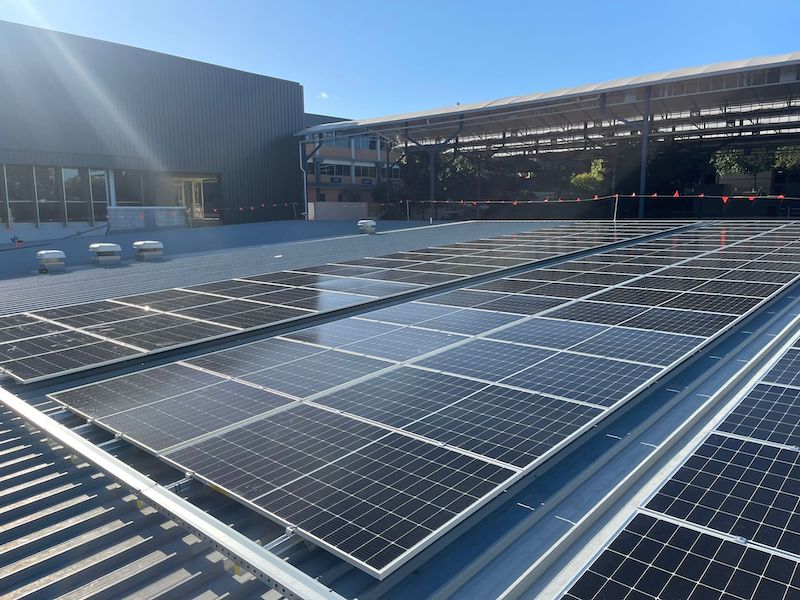Why Solar Panels Are a Good Investment For Schools in Australia

As educational institutions seek to cut operational costs and embrace sustainability, solar panels have become an attractive solution. In Australia, the sun is plentiful in many of our cities, and as such, so are the benefits of harnessing the power it can produce. In our blog below, we share just some of the many reasons why solar panels have become a popular and worthwhile investment investment in Australia, plus highlight how one of our clients, a local school, has effectively leveraged solar power to meet their energy needs.
Financial Benefits and Government Incentives
Reduced Energy Bills and Long-Term ROI:
One of the most significant financial benefits of installing solar panels is the reduction in energy bills. By generating their own electricity, schools and universities can lower their reliance on the grid, resulting in substantial savings. The initial investment in solar panels is often offset by the long-term savings on electricity bills, typically over the system’s 25 to 30 year lifespan. This long-term ROI makes solar panels a smart financial investment.
Government Incentives:
Various government programs provide financial support for schools and universities looking to adopt solar technology. For example, the Queensland Advancing Clean Energy Schools (ACES) program is investing $97 million to assist 800 schools in installing solar panels and implementing energy efficiency measures such as LED lighting and timed hot water systems in order to meet the Queensland Government’s 50% renewable energy goal by 2030 to reduce emission. Although 1200 out of Queensland’s 1240 state schools already benefit from solar and energy efficiency initiatives, the ACES program aims to extend these benefits further and a record number of schools have taken advantage of this initiative. The energy savings from these initiatives are retained by the Department of Education and reinvested into similar programs for the remaining state schools and other educational priorities. Additionally, other incentives like the Small-scale Renewable Energy Scheme (SRES) help make solar installations more affordable by offering rebates and certificates that lower upfront costs.
Environmental Benefits
Reduced Carbon Emissions:
Solar energy is a clean, renewable source of power that helps reduce greenhouse gas emissions. By replacing fossil fuel-based electricity with solar power, schools and universities can significantly lower their carbon footprint.
Sustainability and Climate Education:
Solar panel installations provide a tangible example of sustainability in action. They allow schools to educate students about renewable energy and the importance of reducing environmental impact. By incorporating solar energy data into the curriculum, schools can offer practical lessons on energy conservation and climate science, fostering a culture of sustainability among students.
Educational Opportunities
Real-World Learning Experiences:
Solar panels offer a unique educational opportunity by serving as a living laboratory for students. Schools can integrate the technology into their curriculum, providing hands-on learning experiences that illustrate the principles of renewable energy. This practical application can inspire students to pursue careers in STEM fields, particularly those related to sustainability and clean energy.
Community Engagement and Awareness:
Involving students and the local community in solar projects fosters a sense of ownership and responsibility toward sustainability initiatives. Schools can host workshops, tours, and educational events that highlight the benefits of solar energy, encouraging broader community engagement and awareness.
A Case Study: Iona College
A standout example of the benefits of solar panels in educational settings is the project at Iona College. DS Energy designed and installed a 551kW solar system featuring 1161 Astronergy CHSM60N(DG)F-HC-475W panels across the Art Precinct, Performing Arts Centre, and St Joseph’s IDT Centre. This system is projected to generate 818MWh of clean, renewable energy annually, significantly reducing the school’s energy costs and carbon footprint.
The installation at Iona College not only provides financial benefits but also serves as a practical demonstration of renewable energy’s potential. The project is a great example of how schools can successfully implement large-scale solar systems and achieve substantial savings.
Need Solar Panels For Your School?
Solar panels bring numerous advantages to schools and universities, including cost savings, reduced environmental impact, and valuable educational opportunities. With government incentives and a commitment to sustainability, institutions can lower their operational expenses and carbon footprint while providing practical lessons in renewable energy.
If your school or university is exploring solar energy, DS Energy has experience working with a number of institutions and businesses of various sizes in Brisbane and beyond, and can offer expert guidance and high-quality solar solutions tailored to your specific needs, budget and sustainability goals. To learn more about our services and see how we can help you make the switch, we invite you to get in touch.